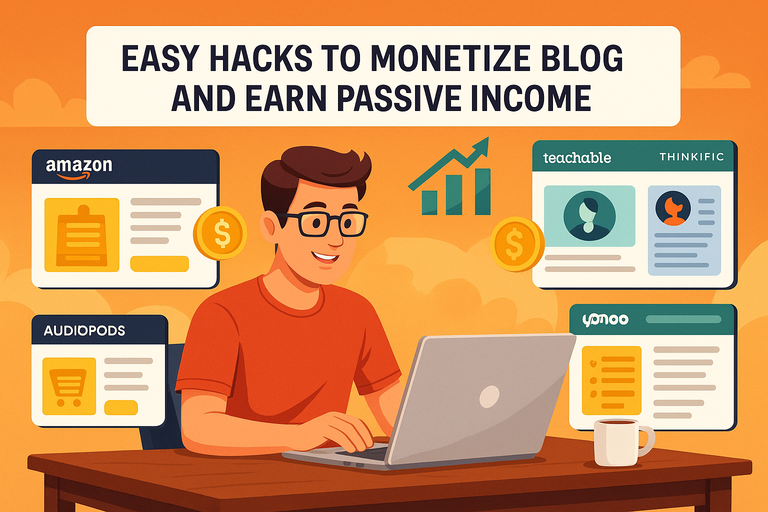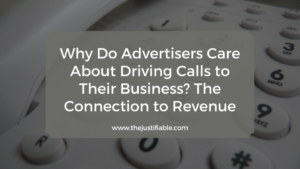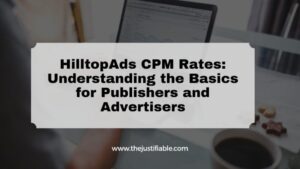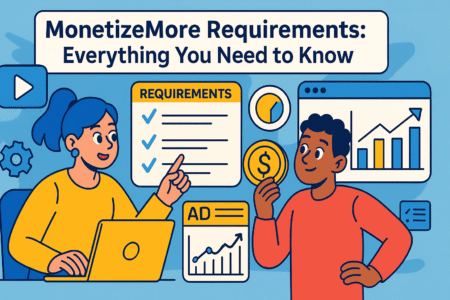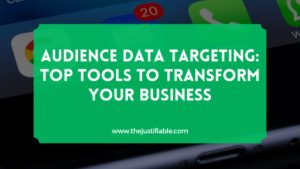Table of Contents
If you’ve been trying to figure out how to monetize blog and earn passive income, but keep getting stuck, you’re not alone.
Many bloggers struggle with turning their passion into steady income without spending endless hours chasing new readers or sponsors. The big question is: How do you set up your blog so that it works for you, even when you’re not online?
In this guide, I’ll break down easy, practical hacks that can help you create passive income streams from your blog without overcomplicating things.
1. Use Affiliate Marketing to Monetize Blog Posts
Affiliate marketing is one of the easiest and most effective ways to monetize blog content because you’re recommending products or services you already believe in.
The best part? Once a post is written and optimized, it can generate income long after you’ve published it.
Choose Programs That Fit Your Niche
The golden rule is relevance. If your blog is about fitness, promoting accounting software won’t resonate with readers.
I suggest starting with affiliate networks like Awin, CJ Affiliate, or Flexoffers because they give you access to thousands of programs in different niches.
Here’s how I usually decide:
- Write down the top 10 problems your audience wants solved.
- Search affiliate programs that directly answer those needs.
- Review commission structures — for example, recurring commissions from SaaS tools (like Mailerlite or SEMrush) often outperform one-off product sales.
When you only promote what aligns with your content, readers feel you’re helping, not just selling.
Write Authentic Reviews That Build Trust
Trust is the backbone of affiliate success. Instead of generic product roundups, write in-depth, hands-on reviews.
For example: “I’ve been using Aweber for my own email list, and one feature I rely on daily is the automation builder—it saves me hours.”
Practical tip:
- Include screenshots or screen recordings showing you actually using the tool.
- Share both pros and cons so readers know you’re being honest.
- Add personal anecdotes — like how switching tools solved a specific problem for you.
People don’t want polished sales talk; they want to hear what worked (or didn’t) for a real person.
Place Affiliate Links Naturally Within Content
Affiliate links shouldn’t scream “I’m trying to sell you something.” Instead, blend them where they make sense. Think of them like seasoning — sprinkle, don’t dump.
A few tricks I use:
- Place links inside tutorials: “Step 2: Sign up for Grammarly here to catch writing mistakes.”
- Add call-to-action boxes mid-post with phrases like: “I recommend [tool] because it’s the one I personally use.”
- Use contextual anchors instead of “click here.” Example: “I manage my campaigns with SEMrush.”
Avoid overloading a single post with too many links, which can overwhelm readers and hurt your rankings.
Track Performance With Analytics Tools
Guessing doesn’t pay. I always track how each affiliate link performs. Most networks provide dashboards showing clicks and conversions, but you can level up with tools like Pretty Links or ThirstyAffiliates to shorten, cloak, and monitor your URLs.
What I recommend:
- Set up Google Analytics events to see where clicks are coming from.
- Test different placements (header vs. body text vs. end-of-post).
- Double down on what’s working and prune what isn’t.
When you monitor results, you stop wasting energy on links that don’t convert and focus only on what brings revenue.
2. Boost Income With Display and Native Ads
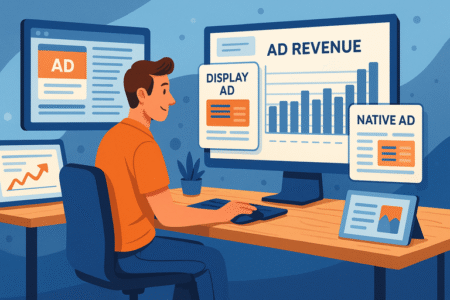
If affiliate marketing is like recommending a product to a friend, display and native ads are like renting out space on your blog for steady income.
They can be a simple, hands-off way to monetize blog content while you focus on writing.
Compare Ad Networks for Higher Payouts
Not all ad networks are created equal. Google AdSense is often the first stop, but it’s not always the most profitable.
From my experience, networks like Mediavine and AdThrive offer significantly higher RPMs (revenue per thousand impressions) once you hit traffic thresholds (50k–100k monthly sessions).
Quick comparison:
- AdSense: Easy to start with, lower payouts.
- Ezoic: AI-powered testing for optimizing revenue.
- Mediavine: Higher payouts, but stricter requirements.
- Raptive: Excellent for lifestyle and food bloggers, premium earnings.
If your traffic is still growing, start small, but as soon as you qualify for a premium network, make the switch.
Optimize Ad Placement Without Hurting UX
Ads should support your income goals without annoying readers. Nothing kills a blog faster than intrusive pop-ups or content buried under flashing banners.
Here’s what I suggest testing:
- Place ads above the fold (visible without scrolling) for better impressions.
- Add in-content ads every 3–4 paragraphs for balance.
- Keep sidebar ads minimal to avoid clutter.
Pro tip: Always check your blog on mobile. A layout that looks neat on desktop can look like a chaotic mess on a phone screen.
Experiment With Native Ads for Better Engagement
Native ads are designed to blend seamlessly with your content, which makes them less disruptive and often more engaging. Platforms like Taboola and Outbrain place sponsored articles that look similar to your blog content, increasing click-through rates.
Where I’ve seen success:
- Embedding native ads at the end of blog posts where readers are already in “what’s next?” mode.
- Testing different styles — product recommendations, sponsored lists, or suggested readings.
- Monitoring CTR closely; if readers aren’t engaging, rotate formats.
The secret here is balance. Native ads should complement your content, not trick readers. Done right, they feel like an extension of your blog instead of a distraction.
3. Sell Digital Products for Scalable Revenue
Selling digital products is one of the smartest ways to monetize blog content because you create something once, and it keeps selling without extra effort.
Unlike ads or affiliates, your profit margins are higher and you control the customer relationship.
Create Ebooks That Solve Reader Problems
The best ebooks don’t feel like “extra blog posts” stitched together. They’re focused, structured, and solve a real pain point your readers face. I
f you run a parenting blog, an ebook like “5-Minute Bedtime Routines for Busy Parents” could be exactly what your audience is looking for.
Here’s how I usually approach it:
- Review your most popular blog posts — they reveal what your audience already cares about.
- Expand that content into a step-by-step guide or deep-dive solution.
- Use simple design tools like Canva or Google Docs templates to make it look professional.
Quick tip: Always include worksheets, checklists, or action plans inside your ebook. Readers value “do-this-now” content far more than theory.
Pricing sweet spot: $7–$29 works well for shorter ebooks. Anything higher usually needs to be positioned as a full toolkit or mini-course.
Design Templates or Printables That Save Time
Templates and printables are like candy for busy readers: quick, practical, and ready to use. For example, if you blog about productivity, you could sell:
- Weekly planner templates (Google Sheets or Notion).
- Printable goal trackers.
- Social media caption templates for small businesses.
One thing I’ve noticed is people will happily pay $5–$15 for a beautifully designed resource that saves them hours of work.
What I recommend:
- Keep templates editable (e.g., Google Docs, Canva, Notion) so buyers can customize them.
- Offer bundles (like a “small business starter kit”) to raise the perceived value.
- Use SendOwl to deliver products automatically after purchase.
This type of product scales beautifully because it doesn’t take more time to deliver 10,000 copies than it does one.
Use Online Marketplaces to Expand Reach
You don’t always have to rely only on your blog traffic. Marketplaces put your products in front of an audience that’s already shopping.
Some strong options:
- Etsy: Great for printables and planners.
- Gumroad: Perfect for ebooks, guides, and digital packs.
- Creative Market: A solid choice for design templates and creative assets.
What I usually suggest is to launch products on your blog first (so you keep 100% of the profit) and then syndicate them to marketplaces for extra reach. This way, you’re building your brand while also tapping into ready-made buyer pools.
4. Offer Online Courses or Mini-Workshops
Courses take the “digital product” idea to the next level. Instead of just selling information, you’re teaching transformation — guiding someone step-by-step toward a specific outcome.
This makes courses one of the most profitable ways to monetize blog content.
Break Down Content Into Structured Lessons
A course should feel like a roadmap, not a random pile of tips. Start with the end result in mind. For example, if your blog teaches freelance writers, your course could be: “Land Your First 5 Clients in 30 Days.”
How I usually structure:
- Module 1: Foundations (mindset, tools, prep).
- Module 2: Core skills (the “meat” of the course).
- Module 3: Implementation (action steps, templates, assignments).
- Module 4: Scaling (next-level strategies).
Keep each lesson short — 10–15 minutes max. Long lectures feel overwhelming. Instead, mix short videos with worksheets or checklists.
Host Courses on Platforms Like Teachable or Thinkific
You don’t need to build a complex tech system from scratch. Platforms like:
- Teachable: Simple, beginner-friendly, great analytics.
- Thinkific: Flexible with custom branding options.
- Podia: All-in-one with courses, memberships, and digital downloads.
Practical example: On Teachable, from the dashboard you’d go to “Courses > New Course,” upload your videos, then drag-and-drop lessons into modules. It’s almost like building a playlist.
These platforms also handle secure payments, student logins, and even coupon codes, so you can focus on creating content instead of chasing tech issues.
Use Email Funnels to Sell Courses Automatically
Courses sell best when paired with automated systems that build trust first, then invite readers to enroll. Email funnels do that beautifully.
Here’s a simple funnel I often use:
- Lead magnet: Offer a freebie like a mini-guide or checklist.
- Nurture sequence: Send 3–4 emails that share tips and stories.
- Course invite: Transition into an offer with urgency (like early-bird pricing).
If you’re using Kit (formerlyConvertKit), you’d set this up under “Automations > Create Automation.” Choose “Joins a Form” as the trigger, then add emails in sequence.
This way, every new subscriber enters a system that warms them up and eventually leads them to your paid course — even while you’re asleep.
5. Build a Paid Membership or Subscription Model

Memberships turn your blog into a recurring income machine.
Instead of chasing one-off sales, you create a space where readers pay monthly or yearly for access to premium content, tools, or community.
Offer Exclusive Content Behind a Paywall
The trick here isn’t to lock everything up. Keep your blog’s free content valuable, but make the paid tier irresistible by offering deeper dives or resources they can’t get anywhere else.
Examples of exclusive perks:
- Weekly behind-the-scenes case studies.
- Premium video tutorials.
- Downloadable templates or resource libraries.
I suggest starting small: Pick one thing your readers constantly ask you for and package it into “members-only” content.
For instance, if you blog about personal finance, you could have a monthly budgeting spreadsheet that updates with new features each quarter.
Tools like MemberPress let you set up paywalls without wrestling with complicated code. From the dashboard, you simply choose which pages or categories are locked for subscribers and which remain public.
Create a Private Community for Added Value
A big reason people pay for memberships isn’t just the content—it’s the connection. Giving your readers access to a like-minded group adds a sense of belonging.
You could create:
- A private Facebook or Discord group.
- A forum hosted directly on your site.
- Monthly live Q&A calls or workshops.
I’ve seen communities thrive when the host stays active. It doesn’t mean you need to be online 24/7.
A quick 15-minute check-in daily to answer questions or highlight a useful member post can keep engagement alive. That interaction builds loyalty, which makes subscribers stay longer.
Use Plugins or Tools to Manage Subscriptions
Managing subscriptions manually is a headache. Luckily, there are plugins and tools that automate the heavy lifting.
Some options worth exploring:
- ProfilePress: Flexible, integrates with WordPress.
- Podia: Great if you want memberships + courses + digital products in one place.
- Patreon: Best for creators who want a low-barrier way to start.
Practical tip: Always set up automated emails for failed payments or renewal reminders. On ProfilePress, for example, you can configure this under “Settings > Emails.” It saves you from awkward one-on-one reminders.
6. Earn Through Sponsored Content and Partnerships
Sponsored content is one of the more direct ways to monetize blog posts: brands pay you to feature their product or service in front of your audience. When done with integrity, it can be a win-win.
Pitch Brands With Tailored Proposals
Brands don’t want generic pitches. They want to know how your audience matches their target customer. Instead of saying “I’d love to collaborate,” show them numbers and context.
What I recommend including in a pitch:
- Who your audience is (demographics, interests, traffic).
- How your blog aligns with their product.
- The type of content you propose (review, tutorial, sponsored list).
For example, if you run a cooking blog, you could pitch a cookware company by suggesting: “I’d love to create a recipe series featuring your non-stick pans. Based on my analytics, my recipe posts average 25,000 monthly views.” That’s much stronger than a one-liner email.
Set Rates That Reflect Your Blog’s Value
Undervaluing your work is common when starting out, but remember: you’re giving brands exposure to a targeted audience.
Some pricing models:
- Flat fee per post (most common).
- Fee + affiliate commission hybrid.
- Long-term package deals (multiple posts + social shares).
As a rule of thumb, many bloggers charge $100–$250 per 10,000 pageviews, but I suggest adjusting based on your niche and engagement.
Tools like Social Bluebook can give you a ballpark, but your actual worth often comes down to the results you can deliver.
Blend Sponsored Posts Seamlessly With Regular Content
Nothing turns readers off faster than a blog that feels like a commercial. Sponsored posts should read just like your regular content, only with an extra layer of helpful detail about the product.
Here’s how to keep it natural:
- Tell a story: “When I switched to [brand’s tool], it cut my editing time in half.”
- Show proof: Add screenshots or photos of you actually using the product.
- Be transparent: Add a disclosure line so readers trust you.
Done right, sponsored posts become some of your most-read articles because they’re both informative and authentic.
7. Leverage Email Marketing for Blog Monetization
If I could only keep one channel for monetization, it would be email.
Unlike social platforms that change algorithms, your email list is yours—and it’s one of the best tools for turning readers into customers.
Create Lead Magnets That Attract Subscribers
People won’t hand over their email just because you ask. They need a reason, and that’s where lead magnets come in.
Popular lead magnet ideas:
- Free checklists.
- Mini ebooks.
- Short video lessons.
- Templates.
Example: On a travel blog, you might offer “The 7-Day Packing Guide” as a free download. In Aweber, you’d go to “Landing Pages & Forms > Create New” to set up a sign-up form that delivers the freebie automatically.
Set Up Automated Sequences That Sell Passively
Once someone joins your list, don’t just send one welcome email and vanish. Build an automated sequence that nurtures trust and naturally introduces your paid offers.
Here’s a sequence I often suggest:
- Day 1: Deliver the lead magnet and welcome email.
- Day 3: Share a personal story + a tip.
- Day 5: Solve a common problem your readers face.
- Day 7: Introduce your paid product (course, ebook, membership).
On platforms like MailerLite, this setup is simple: Go to “Automation > Create Workflow” and build a drag-and-drop sequence. Once done, every new subscriber gets the same carefully planned journey.
Segment Your List for Higher Conversions
Not all subscribers are the same. A reader interested in “SEO tips” may not care about “Pinterest marketing.” By segmenting, you send the right offers to the right people.
Practical ways to segment:
- By lead magnet (what they signed up for tells you their interest).
- By clicks (if they clicked an email about a tool, they’re warmer leads).
- By behavior (buyers vs. freebie-seekers).
Example: In ConvertKit, you can tag subscribers based on which link they click in your email. Later, you can target those tagged subscribers with a more specific offer. This simple step can boost conversions without extra traffic.
8. Repurpose Blog Content Into New Income Streams

If you’ve been blogging for a while, you probably have a goldmine of content sitting in your archives.
Repurposing lets you squeeze more life (and money) out of what you’ve already created.
Turn Blog Posts Into Audiobooks or Podcasts
Not everyone wants to read — some prefer listening while commuting or working out. Turning your best posts into audio versions opens the door to a new audience.
Here’s how I usually do it:
- Pick your top-performing posts based on traffic.
- Record a conversational audio version (don’t just read it word for word, add stories).
- Upload it as a podcast episode on platforms like Spotify or Apple Podcasts.
For monetization, you can:
- Sell ad spots inside your podcast.
- Promote your own digital products mid-episode.
- Bundle the recordings into a paid audiobook on Gumroad or Audible.
This way, a single blog post works twice: once for readers and once for listeners.
Package Old Content Into Paid Bundles
Your archives are likely full of related posts that, when combined, could make a powerful resource. Instead of leaving them scattered across your site, bundle them into a neatly packaged product.
For example:
- A food blogger could turn “10 Pasta Recipes + 5 Meal Plans” into a $15 downloadable cookbook.
- A marketing blogger could compile “SEO Basics + Keyword Research + Link Building” into a mini-course.
Practical step: Export your posts to Google Docs, polish the flow, add fresh visuals or checklists, and then save it as a PDF. Platforms like SendOwl or Gumroad can automatically deliver these bundles to buyers.
I’ve seen people buy content they could technically find for free on a blog because it’s organized, upgraded, and saves them time.
Use YouTube or TikTok To Expand Audience Reach
Your written posts can transform into engaging video scripts. By putting them on YouTube or TikTok, you open new income streams through ads, sponsorships, and affiliate links in video descriptions.
Tips that work well:
- Break long blog posts into short, punchy videos (2–5 minutes for YouTube Shorts or TikTok).
- Add clear CTAs like “Link in bio for the full guide.”
- Repurpose charts or graphics from your blog as video overlays.
Videos have a longer shelf life than most social posts. A single YouTube video can pull in traffic — and revenue — for years if it ranks well.
9. Use SEO To Drive Long-Term Passive Traffic
If you want your monetization strategies to work passively, you need a steady stream of readers finding your content.
That’s where SEO comes in — it’s like planting seeds that keep growing.
Target Evergreen Keywords for Steady Visitors
Evergreen keywords are search terms that people look up consistently over time (like “how to start a blog” or “budget-friendly recipes”).
Here’s how I approach it:
- Use tools like Ubersuggest or free Google Keyword Planner to find long-tail keywords.
- Write content that directly answers search intent.
- Avoid chasing trending topics that fizzle out in weeks.
By focusing on evergreen content, you’re setting your blog up for steady traffic (and income) without constantly chasing new trends.
Build Internal Links to Increase Ad and Affiliate Clicks
Internal linking is one of the most overlooked SEO strategies. Done right, it not only helps Google understand your site but also keeps readers clicking through more of your content.
Example: If you wrote a post about “10 Budget Travel Tips,” link it naturally to your affiliate-heavy post on “Best Travel Credit Cards.”
Practical step: In WordPress, you can highlight text and use the “Insert/Edit Link” tool to link directly to your related post. Over time, this creates a web of connected articles that boosts page views and increases ad and affiliate revenue.
Optimize Old Posts to Keep Rankings Fresh
Search engines love fresh, updated content. Instead of always writing new posts, revisit older ones that are slipping in rankings.
Here’s what I usually do:
- Update outdated stats, tools, or screenshots.
- Add new sections or FAQs to cover fresh questions.
- Re-optimize headlines and meta descriptions for higher click-through rates.
Even small updates can push an old post back onto page one, which means a jump in traffic — and monetization opportunities.
10. Diversify With Multiple Monetization Strategies
Relying on just one income stream makes your blog fragile. Diversifying creates stability and makes sure you’re not at the mercy of one platform or method.
Combine Ads, Affiliates, and Products for Stability
Think of monetization like a three-legged stool. Ads give you baseline revenue, affiliates reward you for recommendations, and digital products put you in full control. Together, they balance your income.
For instance, I know bloggers who make:
- $500/month from ads.
- $2,000/month from affiliates.
- $3,500/month from their own courses.
Each stream may fluctuate, but combined they create reliable monthly income.
Test New Income Streams Regularly
Blogging changes fast. What worked two years ago may not work now, so testing is essential.
Ideas worth testing:
- Adding sponsored newsletters.
- Trying podcast sponsorships.
- Offering coaching or consulting.
Keep a simple spreadsheet of your experiments. Track how much time you spent vs. how much revenue you earned. If something isn’t pulling its weight, drop it and move on.
Build Systems That Run With Minimal Maintenance
The real power of blogging lies in systems — setting things up once so they run without daily input.
Some systems worth creating:
- Automated email funnels for product sales.
- Evergreen Pinterest or social media schedules.
- Content calendars that repurpose posts across multiple platforms.
When these systems are in place, your blog starts to feel less like a job and more like an asset that works for you. That’s where passive income becomes truly passive.


